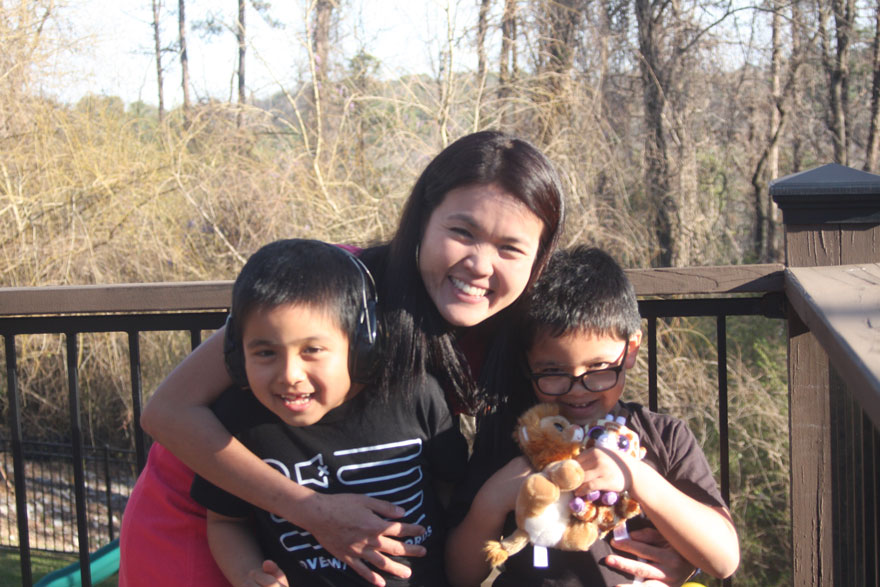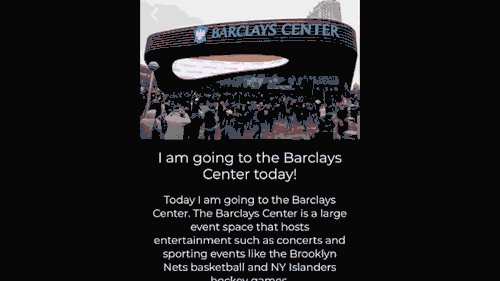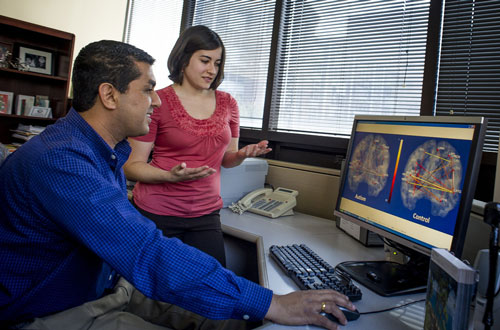Media contact: Savannah Koplon
 If you’re a parent, you know the looks. The looks you get when your child is acting out in public — causing a scene over candy at the grocery store or wailing over a toy in the mall. But here’s the thing: Most parents have a clear idea of what triggered the behavior (a Snickers bar, for example, or Fingerlings).
If you’re a parent, you know the looks. The looks you get when your child is acting out in public — causing a scene over candy at the grocery store or wailing over a toy in the mall. But here’s the thing: Most parents have a clear idea of what triggered the behavior (a Snickers bar, for example, or Fingerlings).
Now imagine what it would be like if your child could spark into an uncontrollable meltdown at any time, often for no discernible reason. Or no predictable reason, anyway.
After Michele Kong’s son Abram was diagnosed with autism at age 4, “we realized very quickly that trivial inputs such as bright lights or a crying baby or a barking dog could result in a verbal outburst or a meltdown,” she said. Kong is a pediatrician at the University of Alabama at Birmingham and Children’s Hospital and a founder of KultureCity, a nonprofit that works to “create acceptance and inclusion for all individuals with unique abilities,” according to its mission statement.
‘It’s not just autism’
Isolation is the opposite of inclusion. And that’s exactly where many parents of children with autism spectrum disorders find themselves, because anywhere from 80 to 100 percent of people with an autism diagnosis experience meltdowns. Public meltdowns often convince parents to stay home.
 Michele Kong with Abram (left) and Juda (right) Image courtesy Michele Kong
Michele Kong with Abram (left) and Juda (right) Image courtesy Michele Kong
When bystanders see someone acting out, they tend to think, or say, something like “control your child!” or “control yourself!” It may not look like it, but that’s exactly what’s happening, Kong says: a “stim” — referring to stereotyped or repetitive motor movements, use of objects, or speech — can be the brain’s way of trying to tune out sensory overload and regain control of a chaotic situation.
The root causes of meltdowns are the sensory processing difficulties in the brains of people with ASD, Kong says. “And we’re realizing that it goes beyond autism,” she added. Individuals with ADHD, Down syndrome, PTSD, cerebral palsy, fetal alcohol syndrome and several other conditions often experience sensory integration problems as well. These sensitivities can quickly lead to sensory overload in noisy, active environments such as restaurants, playgrounds, stores and sporting events.
Kong prefers the term “come-apart,” rather than meltdown, she said. “It’s not just children; it can be a 30-year-old veteran with PTSD who may experience the same issue with sudden loud noises as a 5-year-old with autism at an NBA game.”
She likes to illustrate the point with a YouTube video:
“This is what it means to have sensory sensitivity or dysregulation,” as Kong explains during her public talks.
Brains and filters
 The brain acts somewhat like a coffee filter, Kong says. It focuses attention on a limited set of stimuli and moves redundant inputs into the background. But if you have a sensory integration issue, “your brain can’t regulate all the different input coming at it,” she said. “It can be extremely disorienting.”
The brain acts somewhat like a coffee filter, Kong says. It focuses attention on a limited set of stimuli and moves redundant inputs into the background. But if you have a sensory integration issue, “your brain can’t regulate all the different input coming at it,” she said. “It can be extremely disorienting.”
These “sensory gating” difficulties affect sight, sound, touch, taste and smell. They also interfere with proprioception and vestibulation, related parts of the sensory system “that let you know where you are in space,” Kong said. Some have described feelings of floating in space, and being ungrounded. This is why, for some people, weighted vests or blankets are calming, and for others, being in a corner or having their back against the wall is regulating.”
Researchers are making progress in understanding the mechanisms behind sensory dysfunction. In a review paper published in 2018, Rajesh Kana, Ph.D., Melissa Thye and other members of Kana’s Cognition, Brain and Autism Laboratory at UAB wrote that “while prior research has often focused on the sensory and social features of ASD independently of one another, new theoretical and empirical evidence suggests a stronger relationship between the two than previously thought.” (See “Social sensing: How sensory processing differences may contribute to autism symptoms.”)
Translating for today
This research is fascinating and promising, Kong says. But as a parent of a child with autism, she has a pressing question: “How can we translate this understanding into something that we can do today?”
That question led Kong and her husband, Julian Maha, who is also a physician, to found KultureCity. The nonprofit’s Sensory Inclusive initiative trains venues on how to be welcoming to guests with sensory processing issues and their caregivers. “We approached it from the family and individual angle,” Kong said. “We want to change the mindset of our communities. We want the message to be: ‘We want you here. We are going to meet you in the middle.’ We felt that was the fastest way to have the biggest and most direct impact.”
KultureCity has provided training to venues across the United States and in several countries around the globe. It has worked with more than 200 stadiums, arenas, museums and other venues across the United States, including the homes of the New York Mets, Pittsburgh Steelers, Golden State Warriors and more. KultureCity is an official NBA partner and has hosted special events for the NFL at the Super Bowl and Pro Bowl and for Major League Baseball during the All-Star Weekend. This year, KultureCity was named one of the World’s Most Innovative Companies by the magazine Fast Company.
Stopping before they start
What’s their secret? “Our focus is on prevention,” Kong said. “We teach how to prevent a guest from having a sensory overload. Because it’s always easier to prevent a come-apart than to try to de-escalate once the overload has happened.”
1. Know what to look for
Sensory Inclusive training starts by teaching staff “what sensory sensitivity looks like,” Kong said. Staff members are taught the value of being proactive versus reactive. That includes seeing the attraction or event through new eyes. “If they know it’s going to be a really loud environment” at one point in a game or show, for instance, “they can let the guest know that that is a time when they can step out to go to a quiet space,” Kong said. KultureCity encourages venues to waive “no re-entry” policies and let guests with sensory issues step outside for a few minutes to recover before going back in.
2. Know what to say
Communicating with guests who have ASD or another sensory processing disorder requires some simple changes, Kong said. “You need to use simple, direct language.” For example, in a medical setting, pediatric nurses might tell a child that an upcoming test is “a piece of cake,” she explained. “But for a child with autism, they will be expecting a literal piece of cake.” People don’t realize how much they use “softening” language in everyday speech, “and that can be confusing,” Kong added. A museum docent might say, “We don’t want to be too loud, do we?” Kong said. But that polite suggestion to be quiet can go right over the head of a concrete-thinking person with ASD, Kong said. “It is OK to say ‘You need to be quiet.’ It is also important to always use direct language.”
3. Share the tools
Sensory Inclusive venues have special bags available for guests that contain noise-reducing headphones, a weighted lap pad and other helpful items. They also include KultureCity VIP badges that unobtrusively let staff know that a patron has a sensory processing issue. The venues also have Social Stories personalized to the location. They explain, in child-friendly words and pictures, what to expect. (A list of all Sensory Inclusive venues, along with their Social Stories, is on the KultureCity app.)
 Screenshots from the Social Story for Brooklyn's Barclays Center.
Screenshots from the Social Story for Brooklyn's Barclays Center.
“Knowing what’s going to happen beforehand has the potential to decrease anxiety,” Kong said. “The idea is to pre-expose them to the experience.”
These efforts can make a big difference to parents. “To know that it’s going to be OK that your child is going to get up and walk around — it’s hard for me to put into words how life-changing it is,” said one parent in a KultureCity video.
“Inclusion and accessibility mean everyone,” Kong said. “We want everyone to be part of the community.”
|
Social sensing: Studies suggest how sensory processing differences may contribute to autism symptoms
Speech recognition: Many individuals with ASD are highly attuned to changes in pitch, for example. But recent studies indicate that, while this is true for non-speech sounds, such as music, the ability does not carry over to speech sounds. “Enhanced auditory processing of pitch and oversensitivity to loudness can result in heightened awareness of simple perceptual features of auditory information at the exclusion of complex auditory input such as speech,” the UAB researchers write. Vision: Visual processing differences are now recognized “as one of the earliest stable markers of ASD,” the researchers explain. In brain imaging studies of infants later diagnosed with ASD, investigators have found lower-than-typical activation in several regions involved in visual processing, including the fusiform face area, superior temporal sulcus and the occipital face area. “It is possible that pre-existing visual processing deficits may disrupt developing social skills by preventing the perception of visual cues that signal social rewards, making the cause and effect of social interactions unpredictable,” the UAB scientists write. “Over time, these infants might begin to lose interest in the ‘unpredictable’ social interactions, and instead seek out repetitive and predictable non-social stimulation.” Touch: Touch, the UAB authors point out, plays a key role in social bonding. “Positive tactile stimuli (touch, warmth, odors) can release oxytocin, the neuropeptide primarily involved in social bonding,” they write. “However, the behavioral and neural effects of oxytocin [are] negatively correlated with autistic-like traits. This may lead to a limited seeking of touch in the interpersonal interactions of individuals with ASD.” Putting it all together: Even beyond these individual sensory issues, the brain’s ability to turn a bundle of sensory input into a cohesive picture of the world seems to be damaged in many people with ASD. “The automatic integration of multimodal stimuli creates a predictable social environment out of ‘noise’ and inevitably influences how an individual interacts socially within that environment,” the UAB authors write. “For example, infants at high risk for ASD do not show differential looking during congruent and incongruent speech and lip-movement; this indicates difficulty matching auditory and visual information.” One theory posits a “temporal binding window” that is dysfunctional in ASD. “Timing information is crucial to binding and integrating associated stimuli,” the UAB authors write. “A longer temporal binding window could create a ‘fuzzier,’ unpredictable sensory environment as unrelated stimuli become bound together. Throughout development, important social cues may fail to become integrated or salient. For example, the concurrent lip-movement and the voice of a parent calling a child’s name may not become salient over the other co-occurring stimuli in the environment. This would affect social responses and potentially lead to a preference for restrictive, repetitive behaviors as a refuge from the unpredictable social environment.” |
